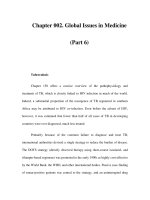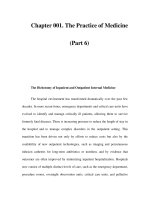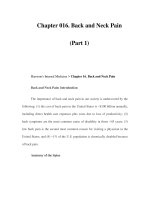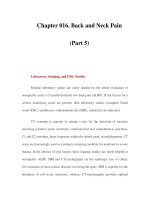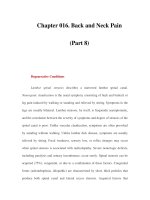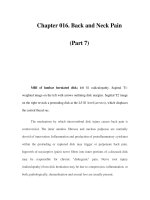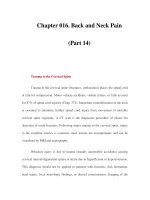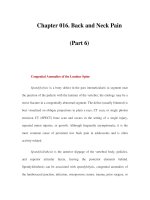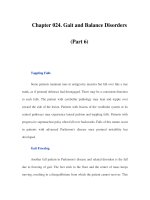Chapter 033. Dyspnea and Pulmonary Edema (Part 6) pps
Bạn đang xem bản rút gọn của tài liệu. Xem và tải ngay bản đầy đủ của tài liệu tại đây (11.22 KB, 5 trang )
Chapter 033. Dyspnea and
Pulmonary Edema
(Part 6)
Distinguishing Cardiogenic from Noncardiogenic Pulmonary Edema
The history is essential for assessing the likelihood of underlying cardiac
disease as well as for identification of one of the conditions associated with
noncardiogenic pulmonary edema.
The physical examination in cardiogenic pulmonary edema is notable for
evidence of increased intracardiac pressures (S3 gallop, elevated jugular venous
pulse, peripheral edema), and rales and/or wheezes on auscultation of the chest.
In contrast, the physical examination in noncardiogenic pulmonary edema
is dominated by the findings of the precipitating condition; pulmonary findings
may be relatively normal in the early stages.
The chest radiograph in cardiogenic pulmonary edema typically shows an
enlarged cardiac silhouette, vascular redistribution, interstitial thickening, and
perihilar alveolar infiltrates; pleural effusions are common.
In noncardiogenic pulmonary edema, heart size is normal, alveolar
infiltrates are distributed more uniformly throughout the lungs, and pleural
effusions are uncommon.
Finally, the hypoxemia of cardiogenic pulmonary edema is due largely to
ventilation-perfusion mismatch and responds to the administration of supplemental
oxygen.
In contrast, hypoxemia in noncardiogenic pulmonary edema is due
primarily to intrapulmonary shunting and typically persists despite high
concentrations of inhaled O
2
.
Further Readings
Abidov A et al: Prognostic significance of dyspnea in patients r
eferred for
cardiac stress testing. N Engl J Med 353:1889, 2005 [PMID: 16267320]
Dyspnea mechanisms, assessment, and management: A consensus
statement. Am Rev Resp Crit Care Med 159:321, 1999
Gillette MA, Schwartzstein RM: Mechanisms of dyspnea, in S
upportive
Care in Respiratory Disease
, SH Ahmedzai and MF Muer (eds). Oxford, U.K.,
Oxford University Press, 2005
Mahler DA et al. Descriptors of breathlessness in cardiorespiratory
diseases. Am J Respir Crit Care Med 154:1357, 1996 [PMID: 8912748]
———, O'Donnell DE (eds):
Dyspnea: Mechanisms, Measurement, and
Management
. New York, Marcel Dekker, 2005
Schwartzstein RM. The language of dyspnea, in
Dyspnea: Mechanisms,
Measurement, and Management
, DA Mahler and DE O'Donnell (eds). New York,
Marcel Dekker, 2005
———, Feller-Kopman D. Shortness of breath, in
Primary Care
Cardiology
, 2d ed, E Braunwald and L Goldman (eds). Philadelphia: WB
Saunders, 2003
